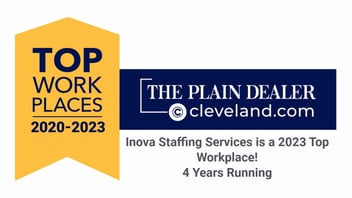Fostering a Culture Where Employees Feel Like They Belong
The following is a guest post from Candace Coleman (CultureWise). Candace is a writer and editor with a background in publishing and public relations.
Fostering a Culture Where Employees Feel Like They Belong

The pandemic transformed the work landscape, as employees emerged from the crisis with revised priorities about what they want and need from their jobs. Their shift in perspective wasn’t just a temporary reaction to the upheaval. Today’s workers, especially younger generations, are no longer willing to settle for the way things used to be. Recent studies show that companies now face the largest lapse in employee engagement in a decade. For example, Gallup reports that organizations are experiencing the lowest ratio of engaged to actively disengaged employees in the U.S. since 2013. So, as leaders begin to strategize for the year ahead, they are dealing with a new problem they could not have predicted and are unsure of how to solve.
The Belonging Factor
As Heidi Brooks, leadership consultant and teacher at Yale School of Management, pointed out in a recent Yale Insights interview, leaders are accustomed to solving problems in their wheelhouse—and re-envisioning work is not an area of expertise for most. So, to counter employees’ waning enthusiasm, many simply tried to boost engagement with surface remedies like fun perks while they went about business as usual.
But these initiatives usually only generate temporary enthusiasm. The issues influencing workers go much deeper than anything feel-good benefits can provide. Brooks explains that the pandemic and other contemporary events initiated a sea change in priorities.
“We have been and continue to be disturbed by fundamental questions of what it means to be human. We don’t know how to really be in a world where we don’t have the answers and we disagree about even how we see the issues. And these are the kind of questions that are coming up about what it means to work together.
We think the question is, should we all be in the office on Friday? The question is actually more, do we even want to work? What is work? And why is work? How can we expand our experience of work to be simultaneously many things at once: be more meaningful, cultivate more belonging, unleash more potential and yet, cost less time, effort, energy and “human-ness”? How can work be better?”
Brad Deutser, author of Belonging Rules: Five Crucial Actions that Build Unity and Foster Performance, believes everything hinges on belonging. His firm surveyed over 15,000 workers across all sectors, and their research shows that belonging is central to personal and organizational success. He offers his insight in a Fast Company article:
“Belonging is a critical determinant of employee job satisfaction, engagement, and effort but also it is the most important predictor of these outcomes. Think about belonging as the bedrock of organizational performance and employee commitment.”
Deuter also points out that belonging has more influence on retention than paychecks.
“Compensation is a moving target and, as such, a temporary offering. The sense of belonging is more lasting, with a deeper connection and motivation for employees to stay with the company. People will leave their jobs if they feel like they don’t belong there.”
He explains that leaders who foster a sense of belonging create an environment where people feel included, accepted, safe, and valued.
“This is not a pass-down-the-organization want-to-have; it has become the must-have, the must-measure, and the must-excel-at imperative for every leader up and down and across every organization.”
Building a Culture of Belonging
The term ‘Belonging’ is a newer addition to the DEI acronym. Diversity, equity, and inclusion policies are hollow unless companies make people in marginalized groups feel like they are welcome members of the team—hence DEIB. But beyond being a core need for DEIB initiatives to work, belonging needs to be centric to workplace culture so that it positively impacts every employee’s experience.
Deutser frames belonging as being in a group where everyone holds space for something of shared importance.
“It is where we come together on values, purpose, and identity; a space of acceptance where agreement is not required but a shared framework is understood; where there is an invitation into the space; an intentional choice to take part in; something vital to a sense of connection, security, and acceptance.”
The framework Deutser refers to is manifested in the behaviors that form a company’s culture.
According to Harvard Business Review, employees feel they belong in an organization when they are:
- Seen for their unique contributions (recognition)
- Connected to their coworkers (trust and communication)
- Supported in their daily work and career development (guidance and opportunities)
- Proud of their organization’s values and purpose (identification)
Leaders who specify, coach, model, and reinforce specific behaviors can help employees realize these standards.
>>> Related Resource: How to Foster a Culture of Open Communication at Work
RECOGNITION
Acknowledging people’s value and contributions to an organization is instrumental in helping them to feel they belong there. Recognition is important for all employees, but the need is even greater for remote and hybrid team members who don’t have the opportunity to interact with leadership and peers in person. Applauding every employee’s wins, effort, and milestones validates their role in the company and deepens their loyalty to the organization.
Leaders should exemplify and encourage all staff to regularly extend meaningful acknowledgment in all directions throughout their organization. In addition, they should cultivate an environment where everyone’s perspectives are enthusiastically received and considered. People feel they belong when team members and managers listen to what they say and respect their opinions.
>>> Related Resource: A Good Manager Will Be These Four Things
RELATIONSHIPS AND COMMUNICATION
Employees must feel a connection to those they work with and for to sense that they belong in the group. Those connections only happen when they have the opportunity to develop relationships built on trust and empathy. Leaders can prioritize behaviors that enhance people’s ability to form healthy ties that make them feel part of the work family.
To cultivate a trust-based environment, leaders should demonstrate and coach transparency. Information should be shared freely throughout the organization, not siphoned into siloed groups. They should create an atmosphere where employees feel comfortable and safe to speak up. And they should set the example of viewing and treating others as worthy individuals, not just people filling roles in the organization.
GUIDANCE AND OPPORTUNITIES
Employees often become discouraged and disengaged when they don’t feel their organization is vested in their development. Organizations that offer everyone opportunities to grow professionally demonstrate that they care about their staff’s well-being and self-worth. Workers are more likely to feel a bond with an employer who helps them further their careers.
Leaders can offer growth support in many ways, including sponsoring educational opportunities and hosting in-house training sessions. They can also create a mentoring network where employees can shadow, learn from, and seek advice from more experienced staff. And they can make sure their culture helps people hone the soft skills, sometimes called power skills, that enable people to move up the professional ladder.
>>> Related Resource: Building a Stronger Team: How Workplace Culture Enhances Power Skills
IDENTITY
As Heidi Brooks noted, one of employees’ most pressing needs in today’s work era is to find more meaning in their jobs. People want to be part of organizations with values that align with their own and offer a sense of purpose to those who work there. They want to be proud to identify with their employer.
Leaders should help employees understand the importance of their roles in achieving organizational success. They should explain to recruits how they fit into the big picture during their onboarding experience. And to be most effective, they should regularly remind all employees how they directly impact team goals and why their contributions matter.
In addition, the core values that may have attracted people to work for the organization shouldn’t just be window-dressing. People want to see these principles activated, so leaders should uphold them through specific behaviors that define their workplace. Employees should see leadership exemplify the values and be assured that all staff are committed to living them out.
Companies that build a culture where employees feel recognized, respected, heard, and encouraged will increase engagement. And if leaders tap into what matters to their staff by igniting a sense of purpose and helping them broaden their skills, they will create a place where people feel like they fit in and want to stay.
Building an inclusive and supportive culture goes beyond helping employees feel fulfilled. It also motivates workers to perform at a high level and pull together as a team so the entire organization operates more effectively.
Inova Staffing Insights
 Dan Barnett, President & CEO of Inova Staffing, says:
Dan Barnett, President & CEO of Inova Staffing, says:
This blog post perfectly captures the post-pandemic shift in employee priorities, something we've been keenly observing in our industry. The emphasis on belonging as a linchpin for personal and organizational success is paramount, aligning seamlessly with our goal of connecting individuals with workplaces where they truly belong and thrive. Creating an environment where everyone feels acknowledged and encouraged isn't just about engagement—it's about building teams that are effective and genuinely motivated to succeed.
Interested in More Employment Resources?
Whether looking for a job or seeking new candidates, the Better Together Blog is packed with advice and insights to help you succeed. Subscribe below to receive the latest content in your inbox—directly from staffing industry experts.

Enter your email address to receive updates when we publish new content.



